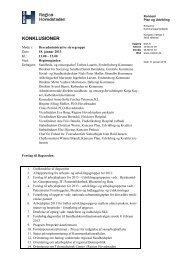Territorial Review Copenhagen - Region Hovedstaden
Territorial Review Copenhagen - Region Hovedstaden
Territorial Review Copenhagen - Region Hovedstaden
Create successful ePaper yourself
Turn your PDF publications into a flip-book with our unique Google optimized e-Paper software.
124<br />
by openness, quality consciousness, employee-driven innovation and critical<br />
sense; qualities that are described as difficult to emulate and attractive for<br />
innovative foreign companies. Challenges that are identified are diverse and<br />
include growth entrepreneurship, regional collaboration, knowledge sharing<br />
between the research and business community, the region‘s image, housing<br />
infrastructure and labour market shortage. On the basis of this assessment,<br />
several actions and 33 initiatives were formulated, ranging from cluster<br />
development, a centre for user innovation and more scientific conferences to<br />
a feasibility study on holding the Olympics in <strong>Copenhagen</strong>. Collaboration in<br />
the context of Øresund is supported as a means of reaching some of these<br />
goals.<br />
The Capital <strong>Region</strong> presented its <strong>Region</strong>al Development Plan in 2008,<br />
called ―The Capital <strong>Region</strong> of Denmark – an international metropolitan<br />
region with high quality of life and growth‖. This plan was submitted for<br />
debate and hearings to citizens, public authorities and civil society<br />
organisations in the Øresund <strong>Region</strong>. The vision for the Capital <strong>Region</strong><br />
expressed in the document is to be one of the leading European metropolitan<br />
regions, characterised by a green profile, efficient traffic-related<br />
infrastructure, education for all, attractive business conditions, diversified<br />
cultural and leisure amenities and an international perspective. This includes<br />
the ambition to be the greenest capital of Europe. Its assessment of qualities<br />
of the region echoes the ―you can have it both‖ strategy suggested in the socalled<br />
<strong>Copenhagen</strong> Brand Book (which aims to describe the profile of<br />
<strong>Copenhagen</strong> for foreign high-skilled labour): the <strong>Region</strong>al Development<br />
Plan aims at a combination of high quality of life and high economic<br />
growth. It focuses heavily on three themes: transport infrastructure,<br />
education and the environment. It repeats the actions from the Business<br />
Development Strategy, which it considers to be the region‘s strategy for<br />
improving business conditions.<br />
These are all laudable initiatives: much energy has been invested in the<br />
assessment, and a wide range of actors has been involved. Strategies like<br />
this can help to create a common vision, shared by the relevant stakeholders,<br />
that can focus financial resources on the most crucial bottlenecks. All of<br />
these strategies are aware of the challenges that globalisation poses to<br />
<strong>Copenhagen</strong>, and they attempt to formulate holistic visions to deal with<br />
them. Three questions are relevant in order to assess their success: do they<br />
provide one common vision; is this vision well-conceived; and will this<br />
vision be implemented? The last question will be answered in the different<br />
sections of Chapter 2 of this <strong>Review</strong>. The first two questions will be<br />
answered below.<br />
Although the different strategies do not conflict with each other, they are<br />
cumulative rather than share the same focus. In combination, they provide a

















